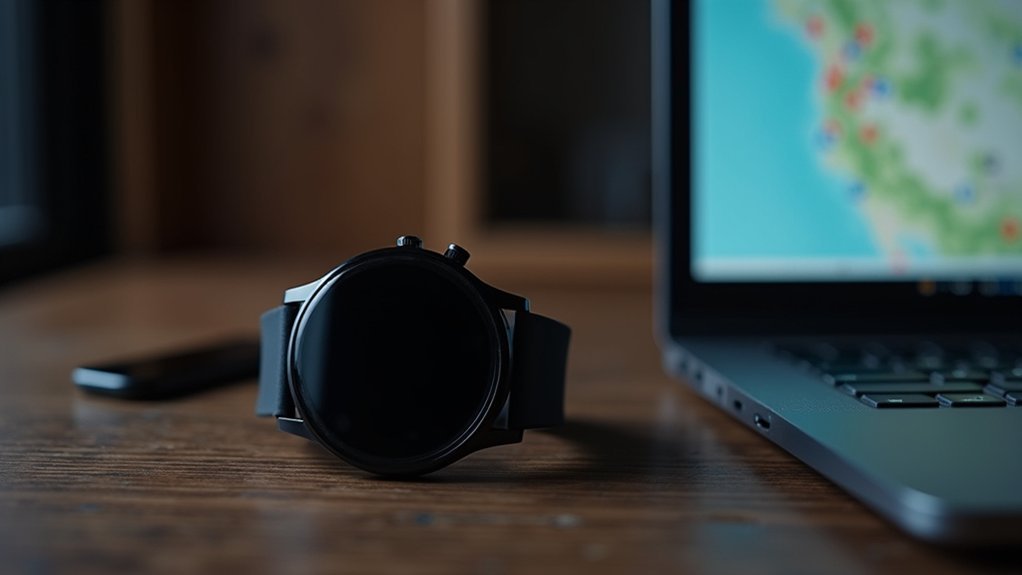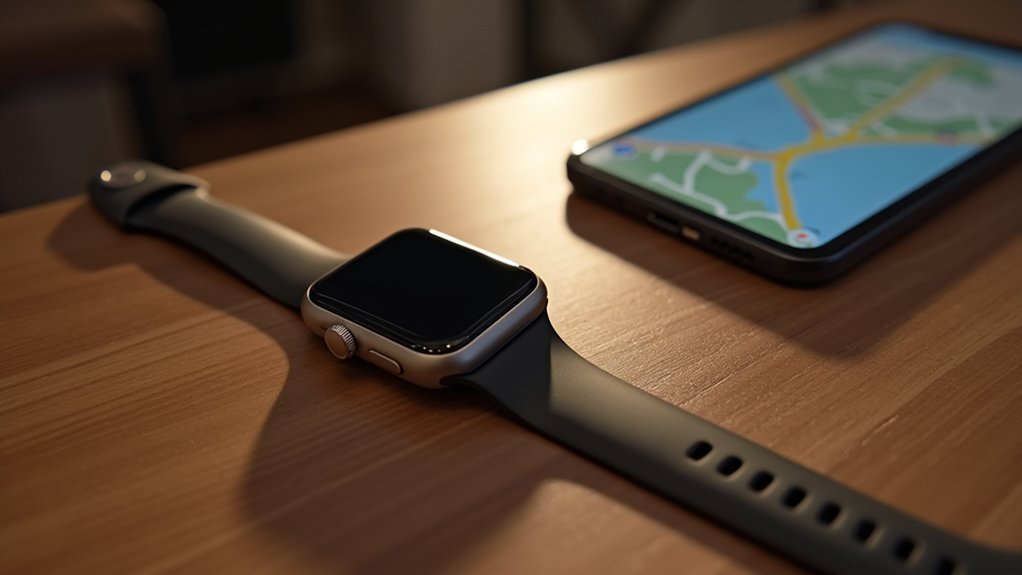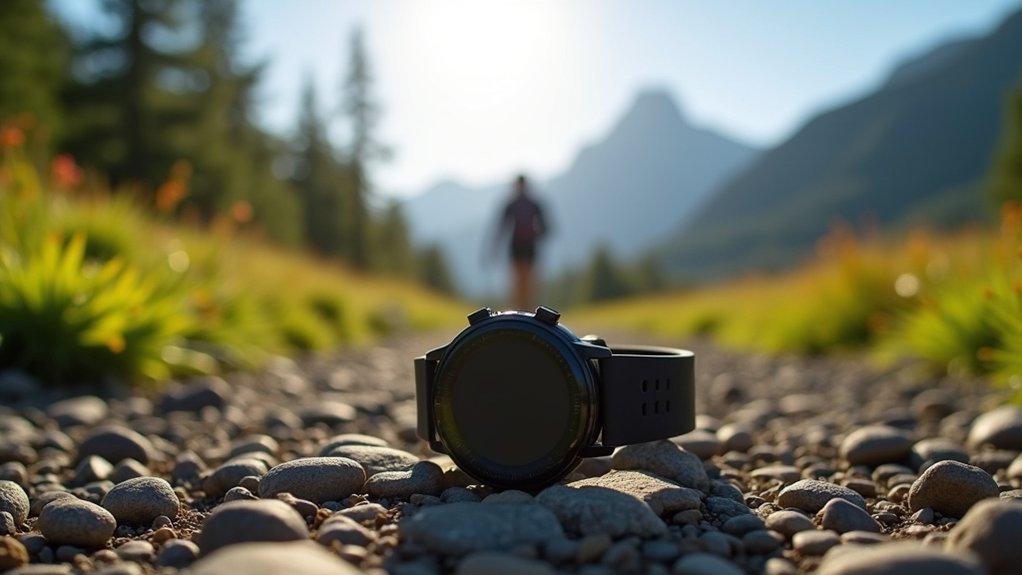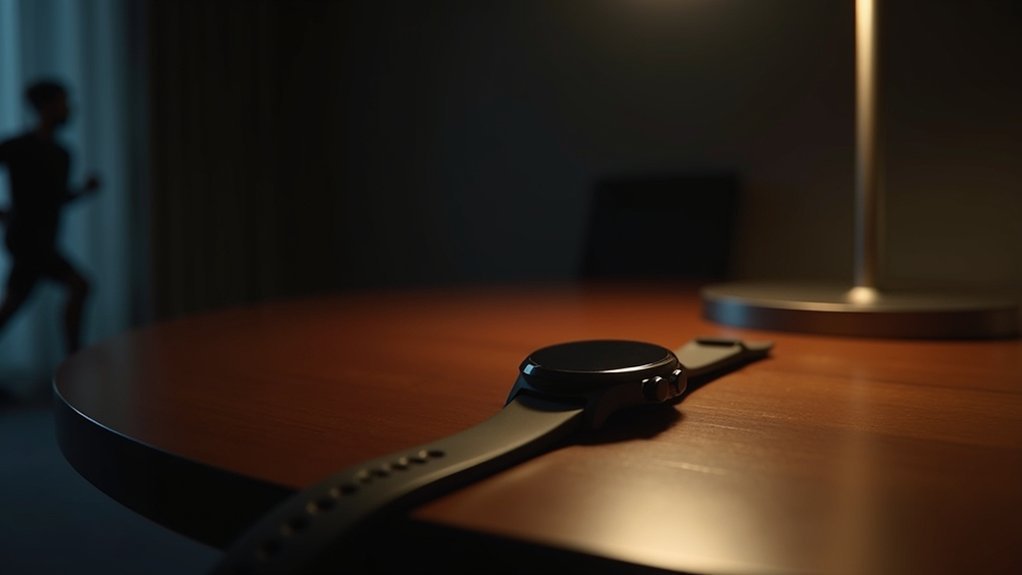GPS accuracy directly impacts your smartwatch’s battery life. Higher precision settings like dual-band GPS or using multiple satellite systems (GPS+GLONASS+Galileo) can reduce battery life by 20-40%. One-second recording intervals drain power twice as fast as smart recording modes. Environmental factors like dense tree cover or urban areas force your watch to work harder to maintain signals. By understanding these trade-offs, you’ll make smarter choices for different activities and maximize both accuracy and battery performance.
Understanding the GPS-Battery Trade-Off in Modern Smartwatches

While smartwatches offer increasingly sophisticated GPS capabilities, they continuously face the fundamental challenge of balancing location accuracy with battery consumption.
When you activate GPS tracking on your device, power usage increases dramatically compared to standard watch functions.
The accuracy-battery dilemma becomes evident when comparing GPS modes. Basic GPS conserves more power but sacrifices some precision, while dual-band GPS delivers superior accuracy at the cost of faster battery drain. Your choice between these options depends on your specific needs.
Modern innovations like AMOLED displays and efficient processors help mitigate power consumption during GPS use. Some manufacturers employ low-powered coprocessors for handling background tasks to optimize battery efficiency during GPS activities.
Additionally, models like the Garmin Enduro 3 with solar charging can deliver up to 320 hours of GPS tracking, while the COROS APEX 2 Pro offers 66 hours without solar assistance.
How Satellite Systems Impact Position Accuracy and Power Consumption
Your smartwatch’s GPS accuracy improves when using multiple satellite systems like GPS and GLONASS together, but this comes at a significant cost to battery life.
You’ll typically gain 15-30% better position accuracy with dual-system tracking, especially in challenging environments like urban canyons or dense forests.
However, enabling both systems simultaneously can reduce your smartwatch’s battery life by 20-40% compared to using GPS alone, forcing you to choose between precise location tracking and extended battery duration. This power demand increases further when poor signal quality causes your device to work harder at obtaining and maintaining a satellite fix.
GPS/GLONASS Tradeoff Analysis
Since satellite navigation systems form the backbone of location tracking in smartwatches, understanding the tradeoffs between GPS and GLONASS is essential for both users and manufacturers.
Enabling both systems offers improved accuracy but comes with power consumption implications you should consider.
- Combining GPS and GLONASS provides more available satellites, enhancing positioning accuracy by 1-5 meters in challenging environments.
- Dual-system tracking increases power consumption by approximately 1%/hour compared to GPS-only operation.
- Urban environments and mountainous terrain benefit most from multi-system integration due to increased satellite visibility.
- Event-based activation can optimize battery life while maintaining accuracy when you need it most.
- Environmental factors like tree cover and buildings greatly impact the benefits you’ll see from using both systems simultaneously.
Swift Navigation’s commitment to customer satisfaction drives continuous improvements in balancing accuracy and battery performance in their navigation technology solutions.
Multi-Constellation Battery Drain
Moving beyond just GPS and GLONASS, the full spectrum of satellite navigation systems presents even more complex power considerations for smartwatch users. When you enable multiple constellations (GPS, Galileo, BeiDou, etc.), you’ll gain better positioning accuracy, especially in urban environments, but your battery will drain faster due to increased signal processing demands.
| Constellation Setup | Accuracy Benefit | Battery Impact |
|---|---|---|
| GPS Only | Moderate | Lowest drain |
| GPS + GLONASS | Good | Medium drain |
| All Constellations | Excellent | Highest drain |
The computational load intensifies as your watch processes signals from more satellites simultaneously. Regional variations also affect performance—you’ll experience different battery life depending on your location and the available satellite coverage. Dual-band GPS further improves accuracy but compounds this power consumption challenge. Recorded activities that utilize GPS functionality significantly increase overall power consumption, affecting the expected battery endurance.
The Real-World Battery Costs of 1-Second vs. Smart Recording

When comparing GPS recording modes, the difference between 1-second and smart recording reveals significant real-world battery implications. Your smartwatch’s battery life can drop by 50% or more when using continuous GPS compared to smart recording modes.
- 1-second recording delivers maximum accuracy but typically limits battery life to 8-24 hours.
- Smart recording adjusts GPS frequency based on your activity, preserving battery while maintaining reasonable accuracy.
- Devices like the Garmin Forerunner can last 20 hours with continuous GPS but up to 20 days in smartwatch mode.
- For casual fitness tracking, smart recording often provides sufficient data without excessive battery drain.
The Coros Pace 3 stands out with an impressive 34-hour battery while using GPS tracking, making it an excellent choice for ultra-endurance activities.
– Competitive activities or precision navigation may justify the battery cost of continuous recording.
Choose your recording mode based on your specific accuracy needs and how long you need your watch to last.
Environmental Challenges: Maintaining Signal Quality Without Draining Power
Environmental challenges pose important hurdles for GPS accuracy while simultaneously threatening your smartwatch’s battery life.
When you’re surrounded by buildings or under dense tree cover, your device works harder to maintain GPS connectivity, markedly increasing power consumption.
Signal quality plays an essential role – stronger signals require fewer acquisition attempts, preserving battery life. Smartwatches need connections with at least four satellites for optimal positioning accuracy in challenging environments.
Your choice of antenna technology matters too; passive antennas consume less power but struggle in challenging environments, while active antennas offer better reception at higher power costs.
Network coverage compounds these issues.
In areas with weak cellular signals, your smartwatch expends more energy maintaining connectivity. This effect varies greatly depending on your specific device hardware and accessories.
Finding the right balance between accuracy and power consumption means understanding these environmental factors and selecting a device with appropriate power-saving techniques for your typical usage conditions.
Optimizing GPS Settings for Different Outdoor Activities

Different outdoor activities require specific GPS settings to balance battery preservation with navigation needs.
For trail running, you’ll want to reduce sampling rates while hiking benefits from longer tracking intervals with TrackBack features.
Your climbing or ultrarunning adventures demand more strategic approaches like solar charging integration or dual-frequency GPS that can be toggled based on terrain complexity and safety requirements. Premium models like the Polar Grit X2 Pro offer up to 43 hours of tracking in dual-frequency performance mode for demanding terrain navigation.
Activity-Specific GPS Recommendations
How you configure your GPS settings can dramatically impact both tracking accuracy and battery life during outdoor activities. Different adventures demand customized approaches to balance precision with power conservation.
- For hiking in challenging terrain, opt for dual-band or multi-band GPS and consider interval tracking to preserve battery.
- Runners should use high-frequency intervals during marathons, with solar-charging watches like the Garmin Forerunner 955 Solar offering extended performance.
- Cyclists can maintain high-frequency GPS settings as bike-mounted devices typically have better satellite exposure and easier charging access.
- Water sports require waterproof devices like the Garmin Fenix, with specialized swimming modes to compensate for signal interference. The Amazfit T-Rex 3 provides exceptional battery life while maintaining accurate GPS tracking for extended water activities.
- Ultra-marathons and multi-day events benefit from solar options like the Garmin Instinct 2X Solar with strategic use of power-saving modes.
Terrain vs. Setting Choices
The physical environment where you train or compete plays a significant role in determining your ideal GPS settings. In mountainous areas, your watch works harder to maintain signal, draining battery faster. Consider using UltraTrac mode for longer adventures or switching to standard GPS if accuracy isn’t critical. Solar charging capabilities can significantly extend battery life during outdoor activities, especially with models like the Garmin Enduro 2 Solar that offers up to 80 hours in GPS mode.
Urban environments with tall buildings present similar challenges—buildings block signals, forcing your device to consume more power searching for connections. For city running, dual-band GPS provides better accuracy but at a battery cost.
| Terrain Type | Recommended Setting | Battery Impact |
|---|---|---|
| Mountains | UltraTrac for ultras | Saves 50-70% |
| Urban | Dual-band GPS | Reduces by 30-40% |
| Rural/Flat | Standard GPS | best efficiency |
In rural or flat terrain, standard GPS offers the best balance between accuracy and battery conservation.
The Future of Low-Power, High-Accuracy GPS Technology
As technology evolves at a rapid pace, innovative developments in GPS chip design promise to revolutionize how your smartwatch balances pinpoint location tracking with extended battery life.
You’ll soon benefit from advancements that deliver both accuracy and longevity.
Future developments include:
- Multi-band GPS systems that enhance accuracy while reducing power demands
- Integration with emerging satellite networks like Galileo and GPS III
- Advanced sensor fusion techniques combining GPS with accelerometers
- Energy harvesting capabilities that could extend battery life indefinitely
- Hybrid location systems that leverage BLE for indoor tracking when GPS isn’t needed
The Amazfit Balance already implements dual-band GPS technology for stronger and more accurate tracking while still maintaining its impressive 14-day battery life.
These innovations will transform your experience, allowing you to track activities longer without sacrificing precision.
Next-generation chips and software optimizations will further reduce power consumption, making today’s battery limitations a thing of the past.
Frequently Asked Questions
Can GPS Accuracy Be Affected by the Watch’s Placement on Wrist?
Yes, your watch’s placement affects GPS accuracy. If you cover the antenna with your wrist or clothing, you’ll reduce signal reception. Position your watch on top of your wrist for ideal satellite visibility.
Do Temperature Extremes Affect Both GPS Accuracy and Battery Life?
Yes, temperature extremes impact your smartwatch’s performance. Extreme cold or heat reduces battery life by affecting battery chemistry, while GPS accuracy suffers less directly but can be compromised when your device struggles with power issues.
How Do Different Watch Case Materials Impact GPS Signal Reception?
Metal cases like stainless steel can weaken your GPS signals due to their conductivity. You’ll get better reception with ceramic or plastic cases, which don’t interfere with radio waves as much.
Does GPS Accuracy Degrade as the Smartwatch Battery Ages?
GPS accuracy itself doesn’t degrade as your smartwatch battery ages. However, you’ll likely experience shorter GPS usage times, and your watch may automatically reduce GPS polling frequency to conserve the diminishing battery capacity.
Can Third-Party Apps Significantly Alter GPS Accuracy or Battery Consumption?
Yes, third-party apps can greatly impact your smartwatch’s GPS accuracy and battery life. They may use intensive background processes, custom algorithms, or continuous data logging that either enhance accuracy or drain your battery faster.
In Summary
You’re facing a clear tradeoff with GPS on your smartwatch: higher accuracy costs more battery life. If you’re tracking a marathon, you’ll need frequent updates, but for casual hikes, smart recording might suffice. Consider your activity’s demands when choosing settings. Environmental challenges like dense forests will force your device to work harder. Thankfully, newer models are becoming more efficient, promising better accuracy without the steep power penalty.





Leave a Reply